北师大版英语九年级Unit 7 Journeys Lesson 21 To the South Pole课件.ppt
- 格式:ppt
- 大小:1.60 MB
- 文档页数:24

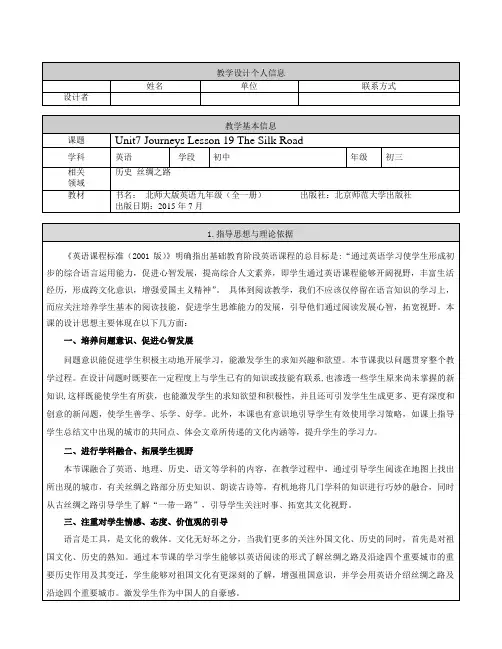
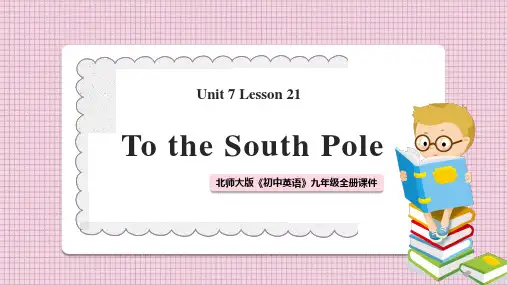
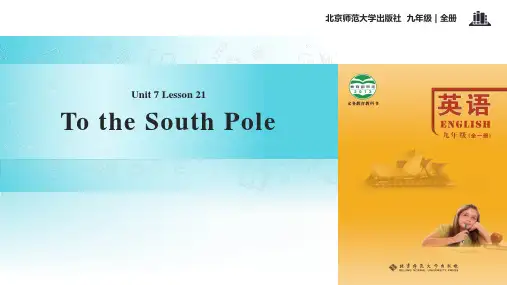
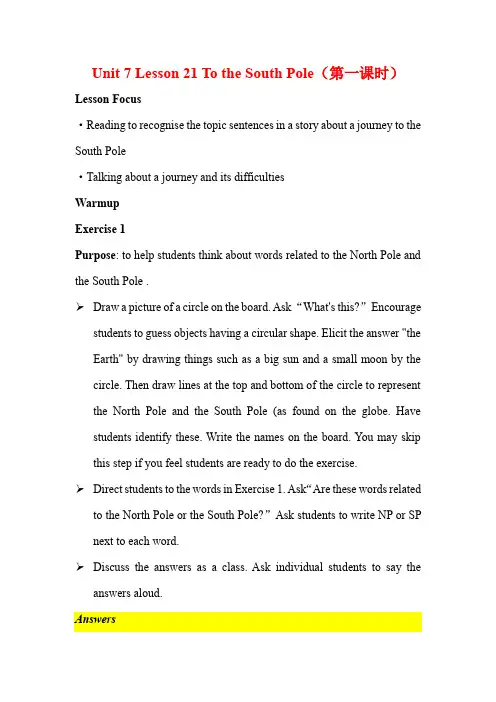
Unit 7 Lesson 21 To the South Pole(第一课时)Lesson Focus·Reading to recognise the topic sentences in a story about a journey to the South Pole·Talking about a journey and its difficultiesWarmupExercise 1Purpose: to help students think about words related to the North Pole and the South Pole .➢Draw a picture of a circle on the board. Ask“What's this?”Encourage students to guess objects having a circular shape. Elicit the answer "the Earth" by drawing things such as a big sun and a small moon by the circle. Then draw lines at the top and bottom of the circle to represent the North Pole and the South Pole (as found on the globe. Have students identify these. Write the names on the board. You may skip this step if you feel students are ready to do the exercise.➢Direct students to the words in Exercise 1. Ask““Are these words related to the North Pole or the South Pole?”Ask students to write NP or SP next to each word.➢Discuss the answers as a class. Ask individual students to say the answers aloud.AnswersAntarctica (SP), Arctic (NP), polar bears(NP), penguins (SP)Exercise 2Purpose: to help students discuss what they know about the South Pole and think about a journey like that➢Ask“What do you know about the South Pole? What is the weather like?”Brainstorm ideas with students and write main points on the board➢Then ask“Who would like to take a journey to the South Pole?”Ask for a show of hands. Have students give reasons why or why not.➢Write the heading Journey to the South Pole on the board. Have students get into groups. Direct them to answer the question: “Why are the journeys to the South Pole difficult?”Have one student in each group take notes.➢Have each team share a difficulty with the class. (Encourage them to present an idea that another group has not yet identified.) Write their ideas on the board.➢Ask students to return to their groups. Have them think about those difficulties and answer the question: “What supplies are needed for a journey like this?”Have them make a checklist of items, noting 10 items that they think are most important. Monitor as students talk, offering help as needed. sin bot➢Ask one member from each team to write the checklist on the board. etogether as a class and pare these lists. Encourage students to explain their choices.Expansion: Show What You Know !Tell students that you are going to give them a little test about Antarctica. Say these three statements aloud and then write three possible answers for each on the board. Have students select and write down their answers (a, b or c).1. What is the coldest it has been in Antarctica?(a) minus 39 degrees C(b) minus 59 degrees C(c) minus 89 degrees C2. How much of the world's ice is found in Antarctica?(a) 25% (b) 60% (c) 90%3. When did the first people reach the South Pole?(a) 1811 (b) 1911 (e) 2011Answers1. с,2. с.3. b✳Roald Amundsen of Norway in December 1911ReadingExercise 3Purpose: to help students scan the text to answer questions based on a text ➢Direct students to the text. Ask“What is interesting about the writingof this text?”Have students note the use of “I”in the writing. (It is written in first person. The writer is writing about his own experiences. ) If you feel your students are ready, you may skip this step.➢Direct students to the instruction line. Ask students to tell you what scanning is. Make sure students understand that scanning a text means looking at it carefully to find some specific information. Say“Scan the text. Find answers to the questions”. Monitor as students read, offering help as needed.➢Go over the answers, asking individual students to say the answers aloud. Encourage them to respond in plete sentences.AnswersAnswers will vary but should include the following:The writer is on an expedition (journey) to the South Pole.He has spent 45 days there.He is there with a doctor and other teammates.Expansion: Keep Talking!Ask students to scan the text for more information. Here are some additional questions you can ask them:1. How's the weather on Day 45 of the expedition? (windy, snowy, subzero temperatures)2. How many hours a day do they usually walk? (12 hours a day)3. How many years ago did Roald Amundsen travel to the South Pole?( more than 100 years ago)Exercise 4Purpose: to help students identify topic sentences in a text➢Direct students to the first paragraph of the text. Ensure that students understand the meaning of the word expedition, which is a journey witha clear focus. Say“Find the sentence in the paragraph that expressesthe main idea of the paragraph”. Give students a few moments to read and think about the paragraph. Elicit This must be one of the most difficult days I've ever had. Explain that we call the sentence in a paragraph that expresses the main idea of that paragraph a topic sentence.➢Direct students to the Reading Help box. Ask them to read the statements. Then say“Look at the second paragraph. Which of the sentences in this paragraph is the topic sentence?”Give students a moment to read and then discuss their ideas with a partner. Elicit This whole trip has been very difficult. Note how this sentence is found at the beginning of Paragraph 2, but that a topic sentence isn't always the first sentence of a paragraph.➢Then direct students to item 2 under the Reading Help box. Say“Now write down the topic sentence for paragraph 2”. After students finish, have them look at the three choices under the topic sentence. I Ask “Which of these sentences supports the topic sentence?”Givestudents a moment to read the sentences and make their choice. Elicit Sometimes I can't get enough sleep. (The other two sentences do not support the topic sentence.) Have students circle b.➢Have students plete the exercise by writing the topic sentences for Paragraphs 3, 4 and 5, and circling the sentence that supports each.Monitor, offering help as needed. is students need support, have them work in➢Go over the answers, having individual students read them aloud. Answers2. This whole trip has been very difficult. (b)3. First, it's not easy to move over the white snow and ice ... (a)4. Another challenge of the journey is preparing food. ( c)5. I think the hardest part is to protect our feet. (a)。
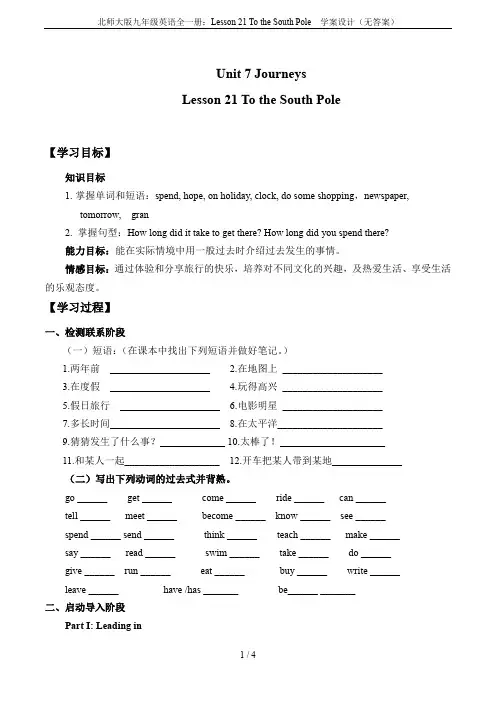
Unit 7 JourneysLesson 21 To the South Pole【学习目标】知识目标1.掌握单词和短语:spend, hope, on holiday, clock, do some shopping,newspaper,tomorrow, gran2. 掌握句型:How long did it take to get there? How long did you spend there?能力目标:能在实际情境中用一般过去时介绍过去发生的事情。
情感目标:通过体验和分享旅行的快乐,培养对不同文化的兴趣,及热爱生活、享受生活的乐观态度。
【学习过程】一、检测联系阶段(一)短语:(在课本中找出下列短语并做好笔记。
)1.两年前____________________2.在地图上____________________3.在度假____________________4.玩得高兴____________________5.假日旅行____________________6.电影明星____________________7.多长时间______________________ 8.在太平洋_____________________9.猜猜发生了什么事?_____________ 10.太棒了!_____________________11.和某人一起___________________ 12.开车把某人带到某地______________(二)写出下列动词的过去式并背熟。
go ______ get ______ come ______ ride ______ can ______tell ______ meet ______ become ______ know ______ see ______spend ______ send ______ think ______ teach ______ make ______say ______ read ______ swim ______ take ______ do ______give ______ run ______ eat ______ buy ______ write ______leave ______ have /has _______ be______ _______二、启动导入阶段Part I: Leading inT:Do you like journey? Where do you want to go? Do you want to travel in the USA?Here are some places in the USA.Part II: Listening practice小听力:Listen to the dialogue and choose the best answer.( ) 1. Where did Betty go on holiday?A.CaliforniaB. HollywoodC. Los Angeles( ) 2. How long did it take her to get there?A.nine hoursB. two yearsC. ni ne o’clock( ) 3. What did Betty see in Hollywood?A.t he moviesB. the movie starsC. the homes of the movie stars大听力:Listen again and answer the questions. (Activity4)三、联动探讨阶段1.How long did it take to get there?how long 常用来提问时间段和长度,表示“多长时间;多长”。
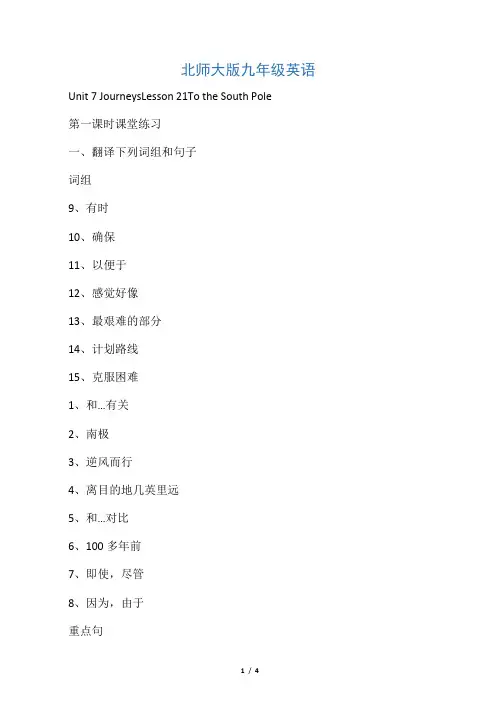
北师大版九年级英语Unit 7 JourneysLesson 21To the South Pole第一课时课堂练习一、翻译下列词组和句子词组9、有时10、确保11、以便于12、感觉好像13、最艰难的部分14、计划路线15、克服困难1、和…有关2、南极3、逆风而行4、离目的地几英里远5、和…对比6、100多年前7、即使,尽管8、因为,由于重点句1、每当我几乎放弃的时候,我就努力去想100多年前他是怎样克服困难的。
2、尽管有时感觉好像没有尽头,这次旅行还是很特别的。
3、此次旅行的另一个挑战是准备食物。
4、即便如此,我们总是确保饮食合理,以便有足够的能量继续我们的旅行。
5、这次探险教会我在成功之前,我们需要克服各种各样的困难,并且绝不放弃。
二、知识点拓展练习1、“one of + the +形容词的最高级+复数名词”,意为“最…之一”。
如:Miss Wang is one of the most popular teachers in our school.王老师是我们学校最受欢迎的老师之一。
2、最可爱的孩子之一______________________________最美丽的国家之一______________________________Shanghai is ____________________________ (中国最大的城市之一).3、1). Sydney is one of ______ cities in the world.A. beautifulB. more beautifulC. most beautifulD. the most beautiful2). China is one of ______ in the world.A. the oldest countryB. the oldest countriesC. much older countryD. much older countries3). We have a lovely room.It’sone of ____ in the hotel.A. niceB. nicerC. nicestD. the nicest4). China is one of _____ countries in theworld.A. largerB. largestC. the largest答案一、词组2、the South Pole1、be related to3、walk against the wind4、a few miles away from our destination5、comparewith6、more than 100 years ago7、even though8、because of9、at times重点句10、make sure11、so that12、feel like13、the hardest part14、plan the route15、overcome all kinds of difficulties1、Whenever I almost gave up, I tried to think of how he overcame his difficulties more than 100 years ago.2、This journey has been special even though at times it felt like it was never going to end.3、Another challenge of the journey is preparing food.4、Even so, we’ve always made surethat we eat the right food so that we can continue our journey with enoughenergy.5、This expedition has taught me that we need to overcome all kinds of difficulties before we can succeed and thatwe should never give up.二、2、one of the most lovely children;one of the most beautiful countries;one of the biggest cities in China3、DBDC。
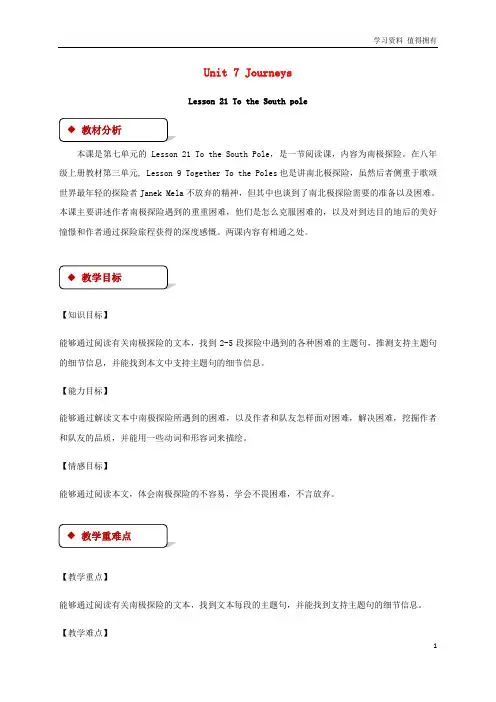
Unit 7 JourneysLesson 21 To the South pole本课是第七单元的 Lesson 21 To the South Pole,是一节阅读课,内容为南极探险。
在八年级上册教材第三单元, Lesson 9 Together To the Poles也是讲南北极探险,虽然后者侧重于歌颂世界最年轻的探险者Janek Mela不放弃的精神,但其中也谈到了南北极探险需要的准备以及困难。
本课主要讲述作者南极探险遇到的重重困难,他们是怎么克服困难的,以及对到达目的地后的美好憧憬和作者通过探险旅程获得的深度感慨。
两课内容有相通之处。
【知识目标】能够通过阅读有关南极探险的文本,找到2-5段探险中遇到的各种困难的主题句,推测支持主题句的细节信息,并能找到本文中支持主题句的细节信息。
【能力目标】能够通过解读文本中南极探险所遇到的困难,以及作者和队友怎样面对困难,解决困难,挖掘作者和队友的品质,并能用一些动词和形容词来描绘。
【情感目标】能够通过阅读本文,体会南极探险的不容易,学会不畏困难,不言放弃。
【教学重点】能够通过阅读有关南极探险的文本,找到文本每段的主题句,并能找到支持主题句的细节信息。
【教学难点】解读文本中南极探险所遇到的困难,以及作者和队友怎样面对困难,挖掘作者和队友的品质。
1. 课前准备:调试光盘与课件、给学生分组、为学生布置预习作业等;教具学具:光盘、大卡片等。
2.Step1. Warm-up1. Let students talk about the south pole and say the symbols they know.2. Let students talk about the difficulties people face on the way to the south pole. Step2. Reading1. Skim the text and answer the questions.2. Find out the topic sentence of each paragraph with the evidence.3. Guess the supporting information of each topic sentence.4. Scan and find out the supporting information.5. Read the last paragraph and answer what we can learn from the passage.Step3. Language points1.expedition n. 考察,远航;考察队,远征军Forty-three members of the expedition were killed.2. against the wind 顶风逆风逆风;迎风The wall screens them against the wind.again 迎着,逆着They were going to sail around the little island, against the tide.3. move over 挪动一下,腾地方Move over this way a little bit.4. route n.路;(公共汽车和列车等的)常规路线;航线All escape routes were blocked by armed police.5. awful adj.糟糕的;可怕的;非常的;极坏的I don't know how often I heard the same awful jokes.6. in good shape 完整无损,处于良好状态,健康情况良好The old actor is still in good shape.Step4. Discussion1.Let students debate over a difficult journey and the challenges they would face. Would you like to take a journey like this one day?Have you ever met with difficulties?How do you face and overcome the difficulties?2. Ask students to brainstorms various difficulties to overcome.3. Let students share with their ideas of journey.Step5. Homework1. Retell the difficulties they face and the ways they overcome them.2. Prepare a speech: How to face and deal with the difficulties in life.3. Surf the Internet and get more information about the South Pole if you like.无。
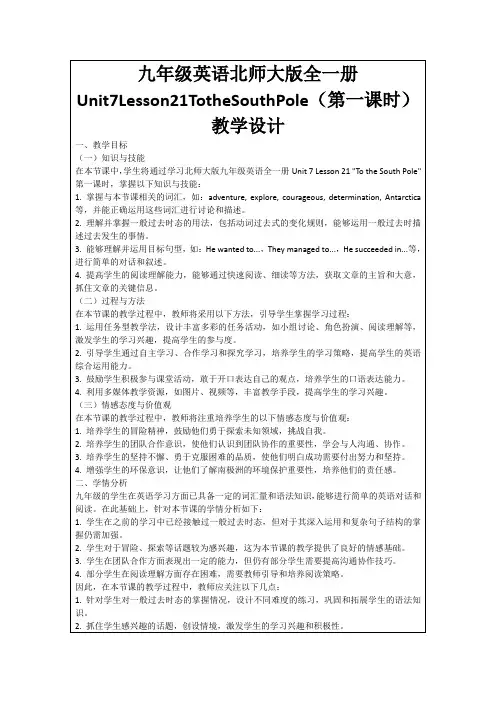
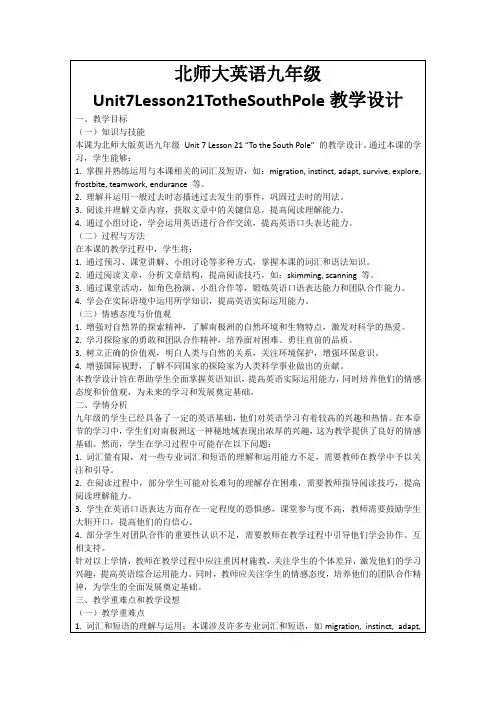
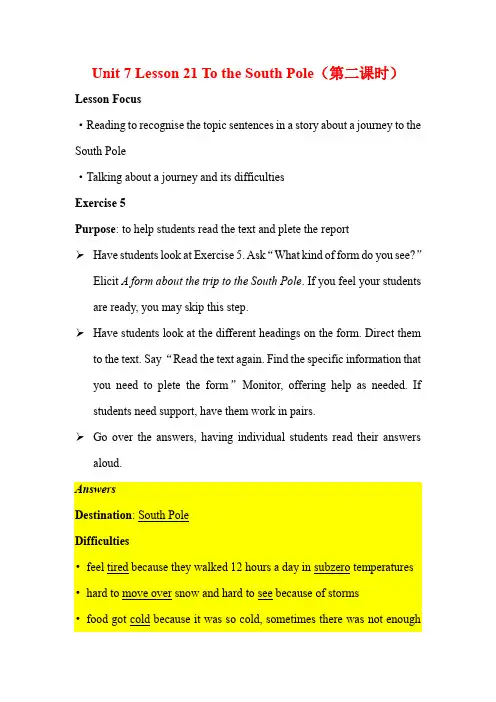
Unit 7 Lesson 21 To the South Pole(第二课时)Lesson Focus·Reading to recognise the topic sentences in a story about a journey to the South Pole·Talking about a journey and its difficultiesExercise 5Purpose: to help students read the text and plete the report➢Have students look at Exercise 5. Ask“What kind of form do you see?”Elicit A form about the trip to the South Pole. If you feel your students are ready, you may skip this step.➢Have students look at the different headings on the form. Direct them to the text. Say Read the text again. Find the specific information that you need to plete the form”Monitor, offering help as needed. If students need support, have them work in pairs.➢Go over the answers, having individual students read their answers aloud.Exercise 6Purpose: to help students express their opinions on taking a journey➢Direct students to the checklist in Exercise 5. Ask Does this list show positive or negative things about the trip?”Elicit Negative. Ask Can you think of some positive things?”Have students share their ideas and give reasons. If you feel students are ready, you may skip this step.➢Ask“Would you like to take a journey like this one day?”Give studentsa few moments to think about their answers. Then have them discusstheir ideas with partners. Encourage them to say why or why not they'd like to take the journey. Monitor, offering help as needed.➢Discuss their answers as a group. Encourage students to share their ideas.SpeakingExercise 7Purpose: to help students give presentations about the journey to the South Pole➢Say Imagine you were on that expedition to the South Pole. After the journey is over, how do you feel?”Elicit words from students (negativeand positive) , such as wonderful,tired, excited, sad, proud ...➢Tell them that as members of the expedition, they have been invited to put together a presentation about their journey to students at a school.Ask What are you going to talk about?”Elicit ideas.➢Then ask students to think about the three main topics that the writer covered in his report about the journey to the South Pole. In groups of four, have them note three main topics (referring them to the report form in Exercise 5, if needed). After discussion, note these three main topics on the board;(1) people on expedition(2) difficulties faced on journey(3) lesson (s) learned➢In groups of four, have students prepare their presentations. In order for your students to feel more confident, set clear guidelines. Here are some tips:⭕Encourage students to provide focus to their presentations by identifying the three main topics and making notes about each ( based on the information from the text in Exercise 3). They can take examples from the text about the people involved and the difficulties they had, and then provide more details to make their presentations more interesting and personal. ( They want their listeners to get a clear idea how they feel about the expedition. ) Finally, they can conclude their presentations by talkingabout what they learned from the expedition. Again, encourage them to provide their personal thoughts here.⭕Don't make the presentations very long. Clearly provide information about the three topics:(1) Who was on the team?(2) What difficulties did you have?(3) What did you learn from the expedition?Note: Write these questions on the board alongside the three topics noted earlier.⭕Make sure students know that they should make notes and not write the entire presentation down. This is meant to be a speaking exercise, not simply reading aloud one's notes. Have them look at the report in Exercise 5 for an example of how to present notes.⭕Assign roles for the presentation. Suggest;•Student A presents the opening statement and discusses who was on the team.•Students B and C share responsibility for discussing the different difficulties.•Student D discusses the lesson (s) learned and provides the closing statement.⭕Tell students to practise! This will help them use clear language and organise their thoughts well.⭕Encourage them to use expression in their voices. They are telling about an exciting expedition.⭕Try to think about their audience when planning or presenting their talk. What might be interesting and helpful for the audience to hear?➢Go over relevant points from the list above.Have students work over these points in class and then assign the preparation and practice of the presentation for homework. If time allows, give some time to practise in class as well.➢Leave time for students to ask questions and or ment after each presentation.Expansion: Do Some Research!Note: For more proficient students, have them research the expedition of either Robert Falcon Scott or Roald Amundsen. Have them answer these questions:Who was this person? Where was he from?When did he begin his journey to Antarctica?What happened on his journey?➢If time allows, do Workbook pages 158 and 159 in class. Alternatively, assign for homework.。
Lesson 21 To The South Pole【教学目标】1.重点词汇和句子。
2.通过阅读培养,提高阅读能力。
【教学重点】1.重点词汇和句子。
2.通过阅读培养,提高阅读能力。
【教学难点】To read and analyze the book extract。
【教学准备】调试光盘与课件、给学生分组、为学生布置预习作业等;学具:光盘、大卡片等。
【教学过程】Step1. Greetings and revision.Step2. Warm-up1 Are these words related to the North Pole or South Pole? Write NP or SP.Antarctica Arctic polar bears penguins2 What do you know about the South Pole? What is the weather like? Why are the journeys to the South Pole difficult? What supplies are needed for a journey like this?Step3. ReadingScan the text Where is the writer? How many days has he spent there? Who is with him?Read the Reading Help. Write the topic sentences of paragraphs 2~5. Then decide which sentence supports the topic sentence.Step4. Reading-againRead the text again and complete the report.Your OpinionWould you like to take a journey like this one day? Why or why not? Step5. SpeakingGroup WorkGive a presentation about the journey to your class.Step6. Homework完成课本对应练习。